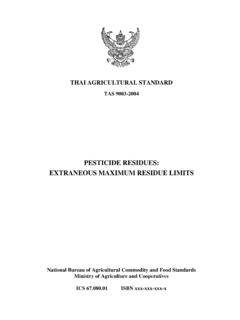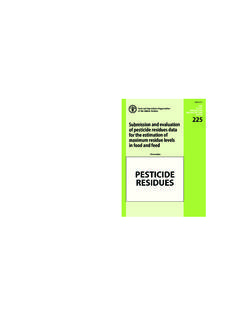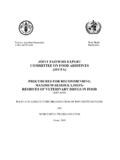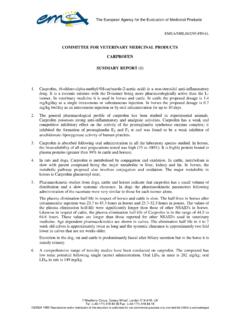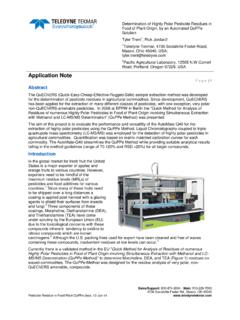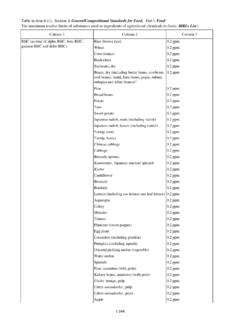Transcription of COMMITTEE FOR VETERINARY MEDICINAL …
1 The European Agency for the Evaluation of MEDICINAL ProductsVeterinary Medicines Evaluation Unit7 Westferry Circus, Canary Wharf, London, E14 4HB, UKSwitchboard: (+44-171) 418 8400 Fax: (+44-171) 418 8447E_Mail: 1999 Reproduction and/or distribution of this document is authorised for non commercial purposes only provided the EMEA is acknowledgedEMEA/MRL/589/99-FINALM arch 1999 COMMITTEE FOR VETERINARY MEDICINAL PRODUCTSFLORFENICOL(Extension to chicken)SUMMARY REPORT (3) is a wide spectrum, synthetic antibacterial. It is structurally related to D (-)threochloramphenicol, but differs from it in two fundamental aspects: firstly, presence of a p-methylsulfonyl group instead of the p-nitro group, secondly, presence of a fluorine atom instead of thehydroxyl group in the terminal primary alcohol function of chloramphenicol.
2 It is used in bovineby intramuscular route of administration and in fish by administration via drinking microbiological ADI of 3 g/kg bw, 180 g per person and a toxicological ADI of10 g/kg bw, 600 g per person had previously been established by the COMMITTEE forVeterinary MEDICINAL , florfenicol is included in Annex I and Annex III of Council Regulation (EEC)No 2377/90 in accordance with the following table:Pharmacologicallyactive substance(s)Marker residueAnimalspeciesMRLsTarget tissues Other provisionsFlorfenicolSum offlorfenicol and itsmetabolitesmeasured asflorfenicol-amineBovine200 g/kg3000 g/kg300 g/kgMuscleLiverKidneyPharmacologicallyac tive substance(s)Marker residueAnimalspeciesMRLsTarget tissues Other provisionsFlorfenicolSum offlorfenicol and itsmetabolitesmeasured asflorfenicol-amineFish1000 g/kg Muscle andskin in naturalproportionsProvisionalMRLs expire application has now been submitted for an extension of the MRLs to poultry, however datawere provided on broiler chicken only.
3 The recommended dose is 30 mg/kg bw/day for 3 days viadrinking a single intravenous administration of mg of florfenicol/kg bw to broiler chicken, theconcentrations of florfenicol in serum declined from 58 500 g/l at 5 minutes after the injectionto 69 g/l at 8 hours post dose. Ten hours after the intravenous administration, no florfenicolcould be detected in serum. The half-time of elimination is 37 minutes. The volume ofdistribution at steady state was 1387 ml/kg indicating wide-spread distribution of florfenicol 1999 After the first oral gavage administration of florfenicol of 42 mg/kg bw/day for 3 days to broilerchicken, the highest concentration of florfenicol in serum (12 200 g/l) was measured after30 minutes and then declined to reach 810 g/l, 8 hours later.
4 Florfenicol could not be detected inthe serum, 60 hours after the last a continuous treatment of broiler chicken with florfenicol in drinking water at a daily doseof 26 mg/kg bw for 18 hours for 3 days, the estimated mean serum concentration of florfenicolwas 711 g/l. No florfenicol was detected in the serum, 72 hours after the terminal repeated oral administration of14C-florfenicol, given twice daily 12 hours apart at20 mg/kg bw/dose for three days, and of total radioactivity administered wereexcreted within 1 day and 7 days after the last dose. In excreta, at 7 days, the parent compoundrepresented the major fraction of the radioactivity (42%), florfenicol amine (25%), florfenicoloxamic acid (5%) and florfenicol alcohol (10%) and the remaining part of radioactivity beingrepresented by a small percentage of three unknown compounds.
5 No monochloroflorfenicol wasdetected in a radiometric study, chicken received14C-florfenicol by oral gavage twice daily 12 hours apartat 20 mg/kg bw/dose for three days ( 40 mg/kg bw/day for three days).Twenty-four hours after the end of oral administration, the levels of radioactivity in edible tissueswere 146 g equivalents florfenicol/kg in muscle, 475 g/kg in skin + fat, 11 148 g/kg in liverand 3125 g/kg in kidney. Then, they declined to reach approximately 50 g/kg in muscle and inskin + fat 5 days after the end of treatment, whereas in liver and kidney significant amounts ofresidues were still found.
6 2403 and 844 g equivalents florfenicol/kg acid digestion followed by extraction with ethylacetate (pH higher than 10), the majorfraction of the radioactivity could be extracted, the percentages of extraction being in themagnitude of 70% for muscle, 60 to for skin + fat, 65 to 80% for liver and about 80% amine was the major metabolite measured in edible tissues of chicken, florfenicol, theonly microbiologically active compounds, being only detected in skin + fat in low concentrations(4%) and in kidney (1%). The other metabolites already identified for the other oxamic acid, florfenicol alcohol and monochloroflorfenicol and one unknowncompound (unknown metabolite 2) in significant amounts, representing , of total radioactivity at day 1 in skin + fat, liver and muscle, respectively.
7 This unknownmetabolite detected in chicken is also present in the rat as unknown metabolite U5. After acidhydrolysis the metabolite is also converted to florfenicol amine. These results indicate that thecurrent determinative assay for chicken liver would quantitatively include the unknownmetabolite which seems to be structurally close to the other metabolites of florfenicol. Anothermetabolite (unknown 1) was found only in liver at very low levels (less than or equal to ). the radiometric study, where chickens received, by gavage, 40 mg/kg bw of14C-florfenicolper day for 3 days, the ratios of the marker residue/total residue were determined by comparingthe values of florfenicol-amine after assaying the matrixes with the analytical method proposedfor monitoring to the total radioactivity levels and were at 1 day after the end of the treatment.
8 50%, 41%, 52% and 50% in muscle, skin + fat, liver, and kidney, a non-radiometric study, broiler chickens received florfenicol according to the recommendedregimen via drinking water at concentrations equivalent to 17 to 30 mg/kg bw/day for 3 days. day after the end of the treatment the concentrations of florfenicol amine were lower than thelimit of quantification for muscle (less than 50 g/kg) and for skin + fat (less than 109 g/kg)whereas in liver and kidney, significant amounts of florfenicol-amine were measured 2862 and1161 g/kg respectively. Florfenicol amine concentrations declined to reach 2038 and 679 g/kgin liver and kidney, 1 day after the end of the treatment and to 1215 and 484 g/kg in liver andkidney, 3 days after the end of the treatment.
9 Seven days after the end of the treatment, theconcentrations of florfenicol amine were below the limit of quantification for liver (less than461 g/kg) and could be still measured in kidney (136 g/kg).3/3 EMEA HPLC analytical method proposed to monitor residues of florfenicol in edible tissues ofchickens was fully validated according to the requirements of Volume VI of The RulesGoverning MEDICINAL Products in the European Community. The limits of quantification are 100,200, 150 and 1500 g/kg for muscle, skin + fat, kidney and liver respectively, the limits ofdetection being 5, 39, 250 and 5 g/kg for muscle, skin + fat, liver and kidney, respectively.
10 Aconfirmative method, based on HPLC-MS/MS has also been the establishment of MRLs for cattle and fish, the MRLs were based on the microbiologicalADI (180 g per person), the only microbiologically active compound being the metabolism study carried out in chicken after single oral administration, themicrobiologically active compound could not be detected in muscle and liver, and represented 4%and 1% in skin + fat and kidney, respectively. Therefore, 12 hours after the end of theadministration via drinking water, the microbiological active compounds will represent of the microbiological ADI.










